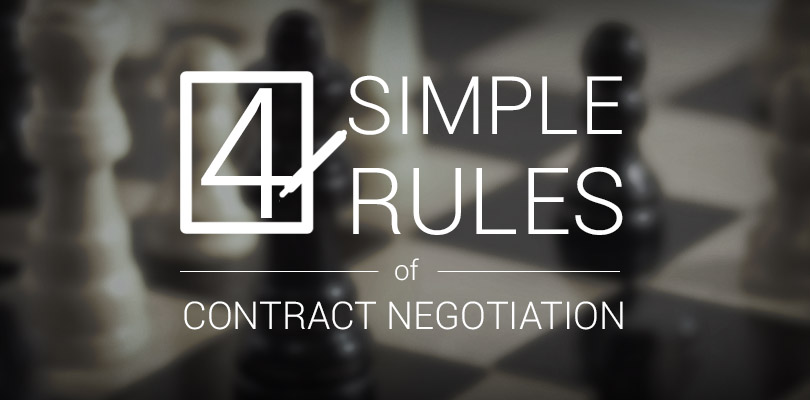
Disclaimer: This obviously isn’t every rule in the web business bible, but every designer/developer should consider adopting these rules when starting out.
Contract negotiation is the single biggest area where beginner designers can get seriously screwed. A bad contract—or worse, no contract—can result in things like: not getting paid for work or having a misunderstanding blow up into a lawsuit. Contracts are not necessarily the most fun aspect of running a web business, but they are critical for reasons that would fill another post entirely.
I recently attended a roundtable discussion at AIGA, the professional association for design. A few of us were CEOs with ten or more years of experience running a design and development shop. A question from the audience was asked: “What are some of your practices in contract negotiation?” The discussion that followed made me realize that I wasn’t alone in my view of these practices.
1) Don’t negotiate your rate.
If a potential client pushes you to lower your rate, walk away. The client pushing you on changing your rate doesn’t value your work, and a client who doesn’t value your work or your time is never worth it. In all likelihood they’ll be your worst and most difficult clients. A key thing to remember in your negotiating is that you and client need to come into the discussion as equals.
2) If you have known unknowns, work on a time and materials billing system.
As much as possible, work on time and materials for large projects with multiple unknowns. There are cases when working on a flat project fee is more profitable, and sometimes substantially so, but these are specific instances. Selling on value-based pricing can be hugely profitable, in fact I’m in the midst of writing a longer, more investigative piece on value-based vs. time and materials pricing, so be on the lookout for that. But here’s the rub: in our world of design & development on larger projects, the probability is too high of encountering unknown unknowns. Time and materials pricing ensures you get paid for all the work that you do. Look out for the upcoming article on value based vs. time based pricing for a full explanation of the pieces of each and how to fully utilize each method.
Pro-tip:
- Known knowns – I know that a problem exists, and I know how to solve it. Yay!
- Known unknowns – I know that a problem exists, but I don’t know how to solve the problem. Or, I know I am going to run into a certain kind of problem. Hmmm.
- Unknown unknowns – I had no idea that I was going to run into this problem and I don’t know how to solve it now that I’m here! Yikes!
3) Never do business with attorneys.
There are a couple of reasons why we hold to this. First off, lawyers are generally difficult people to work with. Second, it costs a lawyer nothing to sue you, but it will always cost you to defend yourself. A lot of the time, lawyers will use the knowledge that it isn’t worth it for you to defend yourself to get you to bend to what they want, at your expense. The headache, not to mention the expense, is simply not worth the risk. Which brings me to my next item…
4) Don’t be afraid to walk.
Life owning a studio, being a freelancer, or even running a bigger shop can be a struggle. One of the biggest mistakes new and even experienced developers make is saying “yes” to projects or people that walks through the door when they really should not. If you discover something about a new client or new project during the contract negotiation project that gives you bad vibes, don’t be afraid to walk away entirely from the project. On top of the benefits of not doing business with difficult clients, walking away can make your team respect you even more. They’re the ones that will probably have to deal with your clients, so showing them that you respect them by making their lives easier proves you’re the leader you want to be.
If you do turn someone down for business, there are graceful ways to say “no.” We usually tell people one of the following things:
- We don’t feel like it’s a good fit.
- Our schedule is packed right now and we can’t take your project for [longer than they can wait].
Don’t forget to always recommend someone else for this client though. You still want to be professional and help them find someone who is a better fit.
At the end of the discussion, my colleague asked the rest of us at the roundtable, “How many of you also follow these same practices?” I raised my hand. The other CEOs also raised their hands. That’s because most of these practices came from painful learning experiences, situations where a little knowledge beforehand would have saved a lot of time and money.
Contract negotiation is just one step in a much larger business process of crafting and modifying contracts with clients. The highlights of any contract agreement are: project scoping, budget and price, deliverables, payment structure and final agreement. Right now my team is working on BrainLeaf, a tool that will simplify the project scoping part of contract negotiation. If you haven’t already, sign up for Beta to check it out.
Do you have rules that you live by in your business? I know I haven’t covered everything, but hopefully I’ve covered the basics. Let me know if there’s a rule you would have included that I left out.





